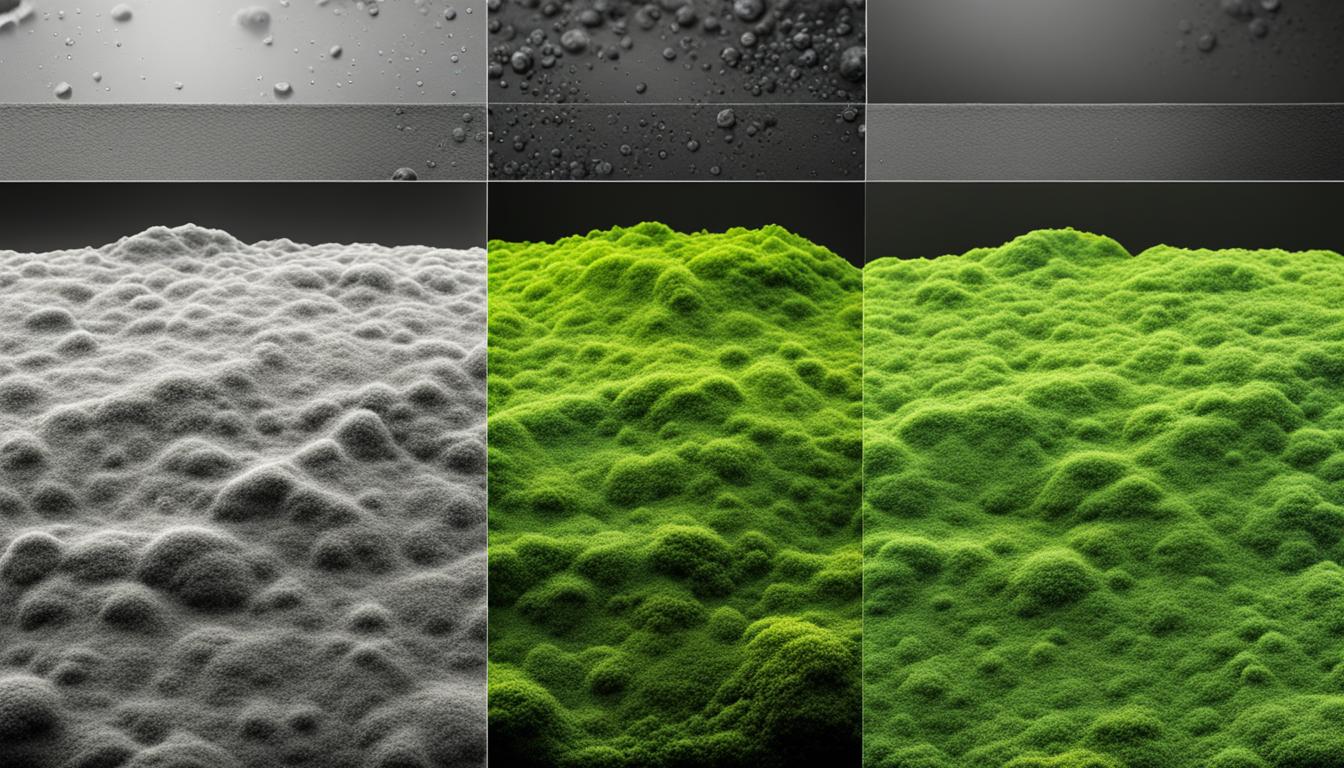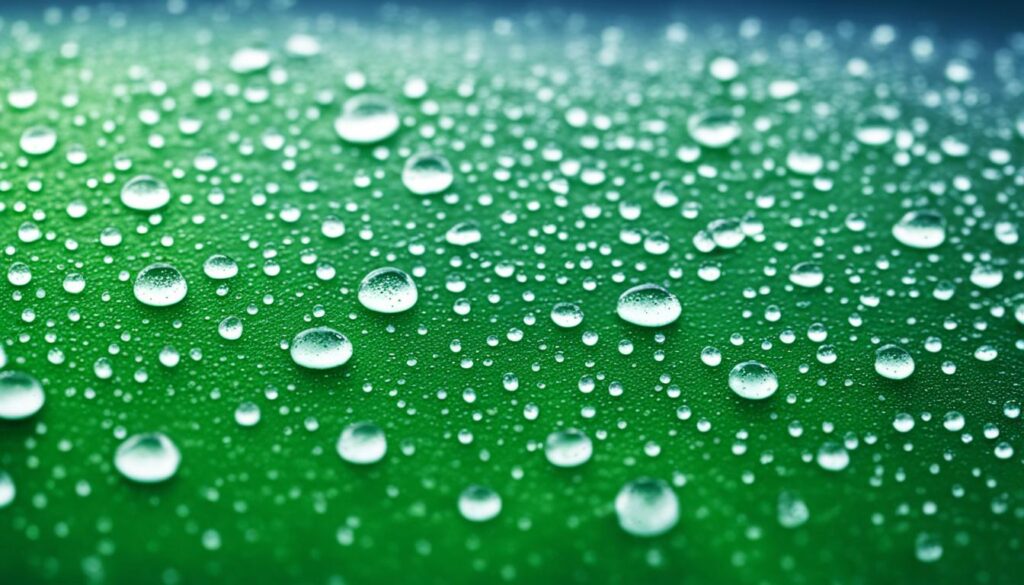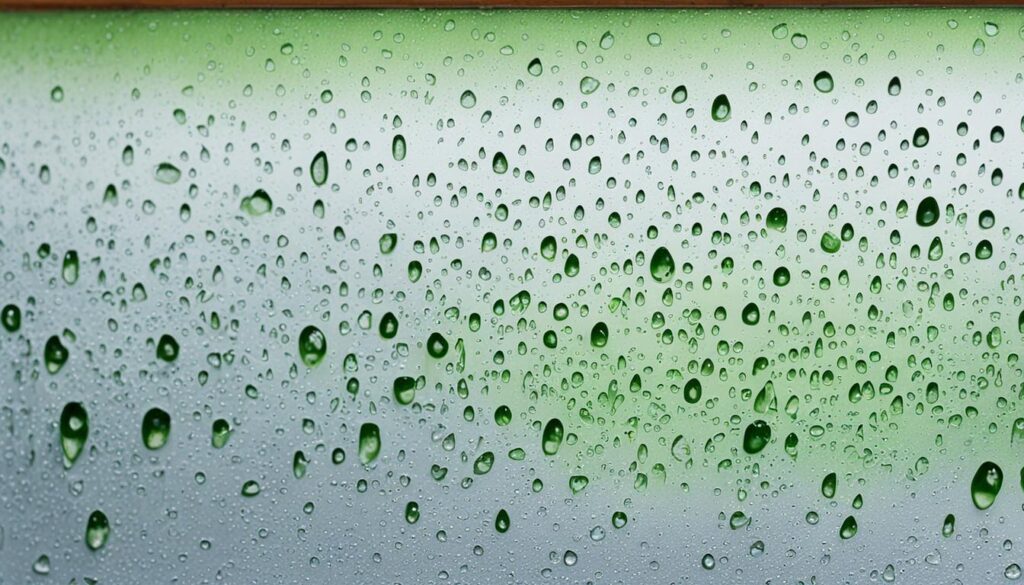
Dew Point’s Impact on Mold Growth Explained
Welcome to our comprehensive guide on the connection between dew point and mold growth. In this article, we will explore the effect of dew point on mold proliferation and its impact on mold development in various environments. Understanding this relationship is crucial for taking proactive measures to prevent mold in your home or workplace.
Key Takeaways:
- The dew point plays a significant role in mold growth by creating favorable conditions for mold spores to thrive.
- High dew points contribute to moisture accumulation, increasing the likelihood of mold development.
- Monitoring and controlling the dew point is crucial in preventing mold proliferation.
- Understanding the connection between dew point and mold growth can help in implementing effective mold prevention strategies.
- Taking proactive measures to manage moisture levels and temperature can mitigate the risk of mold growth associated with dew points.
Understanding Dew Point and Mold Growth
In order to understand the connection between dew point and mold growth, it is important to first grasp the concept of dew point and its role in creating favorable conditions for mold proliferation. The dew point refers to the temperature at which air becomes saturated with moisture, leading to condensation.
When the temperature of a surface falls below the dew point, moisture in the air begins to condense and settle on the surface. This moisture accumulation creates a damp environment that is highly conducive to mold growth. Mold spores, which exist naturally in the environment, can then feed on this moisture and multiply rapidly, resulting in mold infestations.
Moisture levels, temperature, and the dew point are interconnected factors in mold growth. High moisture levels, combined with warm temperatures and a dew point that exceeds the temperature of a surface, create an ideal breeding ground for mold.
It is worth noting that different types of mold have varying sensitivity to dew point and moisture levels. Some molds may require higher levels of moisture to proliferate, while others can thrive in low humidity environments.
By understanding the relationship between dew point and mold growth, it becomes clear that controlling moisture levels and monitoring the dew point are crucial steps in preventing mold infestations. Regularly inspecting and addressing areas prone to excess moisture, such as basements, bathrooms, and kitchens, can help reduce the risk of mold growth.
Awareness of the dew point and its impact on mold proliferation empowers individuals to take proactive measures to mitigate moisture levels and prevent mold infestations.
Next, we will explore the direct correlation between dew point and mold development, shedding light on how high dew points can lead to increased moisture accumulation and mold growth.

The Influence of Dew Point on Mold Proliferation
Before delving into the relationship between dew point and mold growth, it is important to note that mold requires a combination of favorable conditions to proliferate. In addition to moisture, mold spores also require an organic food source and oxygen to thrive.
| Dew Point Temperature | Moisture Conditions | Mold Growth Potential |
|---|---|---|
| Below freezing | Minimal moisture | Unlikely to support mold growth due to low moisture levels |
| Above freezing | Minimal to moderate moisture | Potential for mold growth if other conditions are met |
| Above freezing | High moisture levels | High potential for mold growth |
As the table illustrates, when the dew point temperature exceeds the surface temperature, it creates a moisture-rich environment that can promote mold growth. In such conditions, moisture from humid air or water sources can accumulate on surfaces, providing the necessary conditions for mold spores to flourish.
By understanding the effect of dew point on mold proliferation, individuals can take proactive measures to control moisture levels and maintain optimal conditions that discourage mold growth. This may include improving ventilation, using dehumidifiers, and promptly addressing any sources of moisture in indoor spaces.
With a comprehensive understanding of how dew point and mold growth are interconnected, we can now explore the direct link between dew point and mold development in greater detail in the next section.
The Link between Dew Point and Mold Development
In the previous section, we discussed the impact of dew point on mold growth and how it plays a critical role in creating favorable conditions for mold proliferation. Now, let’s dive deeper into the direct correlation between dew point and mold development.
When the dew point is high, it means that the air is already saturated with moisture. This moisture can accumulate on surfaces, creating an environment conducive to mold growth. As the dew point rises, so does the potential for mold proliferation.
To understand this correlation better, let’s consider an example. Imagine a bathroom with high humidity levels and a dew point close to the ambient temperature. The moisture in the air will condense on cooler surfaces such as walls, ceilings, or shower curtains. Over time, these damp surfaces become a breeding ground for mold spores, leading to mold growth.
In summary, the higher the dew point, the greater the moisture accumulation, which provides ideal conditions for mold spores to thrive and develop.
Preventing Mold Growth by Managing the Dew Point
To prevent mold growth, it is crucial to control the dew point and minimize moisture accumulation. Here are a few steps you can take:
- Ensure proper ventilation in areas prone to moisture, such as bathrooms, kitchens, and basements.
- Use dehumidifiers to reduce humidity levels and maintain an optimal environment.
- Insulate and seal windows, doors, and other areas where air can escape or enter, preventing condensation and moisture infiltration.
- Regularly clean and dry surfaces that are susceptible to moisture, such as shower walls, sinks, and countertops.
By proactively managing the dew point and controlling moisture levels, you can significantly reduce the risk of mold growth in your living or working spaces.
Next, we will explore the specific conditions that are favorable to mold growth and the pivotal role the dew point plays in promoting mold proliferation.

| Conditions Favorable to Mold Growth | Effect of Dew Point |
|---|---|
| High humidity | Promotes moisture accumulation |
| Poor ventilation | Restricts air circulation and moisture evaporation |
| Damp or wet surfaces | Provides a breeding ground for mold spores |
| Warm temperature | Increases mold growth rate |
Conditions Favorable to Mold Growth and the Role of Dew Point
When it comes to mold growth, certain conditions create an optimal environment for its proliferation. Understanding these conditions and their connection to the dew point is crucial in preventing mold infestations.
Moisture: Mold requires moisture to grow and thrive. Excess humidity or water intrusion can lead to the accumulation of moisture, providing an ideal breeding ground for mold spores. The dew point, which is the temperature at which air becomes saturated and condensation occurs, plays a pivotal role in moisture accumulation.
Temperature: Mold thrives in specific temperature ranges, typically between 77°F and 86°F (25°C and 30°C). Higher temperatures increase the rate of mold growth, while lower temperatures slow it down. The dew point temperature indicates the point at which air becomes saturated with moisture, creating conditions conducive to mold development.
Humidity: High humidity levels contribute to moisture in the air, increasing the likelihood of mold growth. The dew point reflects the humidity level at which moisture condenses, highlighting the potential for mold proliferation.
By monitoring and controlling the dew point, we can effectively manage the moisture levels in our environment and mitigate the risk of mold. Implementing measures to maintain proper ventilation, humidity control, and moisture prevention can significantly impact the prevention of mold growth.
Failing to address elevated dew points and the resulting moisture buildup can lead to mold infestations that pose serious health risks and significant property damage.
| Factors | Dew Point Below Ambient Temperature | Dew Point Above Ambient Temperature |
|---|---|---|
| Moisture Accumulation | Less likely to accumulate moisture | More likely to accumulate moisture |
| Mold Growth | Slower growth potential for mold | Higher potential for mold growth |
| Mold Prevention | Reduced risk of mold infestations | Increased risk of mold infestations |
The table above highlights the contrasting effects of dew points below and above ambient temperatures on moisture accumulation, mold growth potential, and mold prevention. Monitoring the dew point and considering its impact on these factors is essential in creating a mold-resistant environment.
By understanding the connection between dew point and mold growth, individuals and organizations can take proactive steps to safeguard their health, well-being, and property from the detrimental effects of mold infestations.
Conclusion
Throughout this article, we have delved into the relationship between the dew point and mold growth. It is clear that the dew point plays a crucial role in the development and proliferation of mold in various environments.
By understanding the impact of the dew point on mold growth, we can take proactive measures to prevent its occurrence. Moisture accumulation, often influenced by high dew points, creates the ideal conditions for mold spores to thrive. Therefore, it is essential to monitor and control the dew point to mitigate the risk of mold.
Whether it’s a residential or commercial setting, maintaining optimal indoor humidity levels is key to preventing mold growth. Regular inspection and maintenance of HVAC systems, proper ventilation, and moisture control strategies are vital steps in effectively managing the dew point and minimizing mold development.
Remember, mold not only poses health risks but can also cause structural damage and impact the overall indoor air quality. By staying informed about the relationship between the dew point and mold growth, we can create healthier and mold-free environments for ourselves and those around us.




